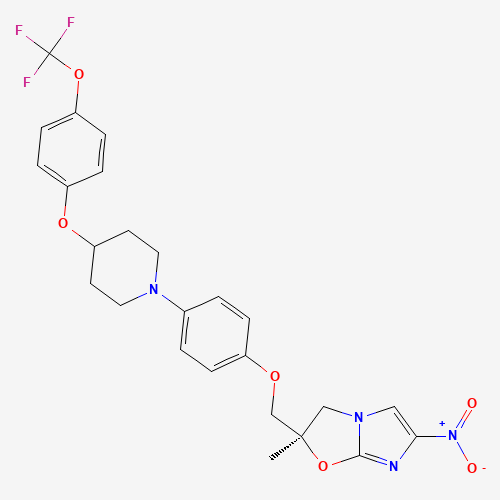| Pharmaceutical Information |
| Drug Name |
Delamanid |
| Drug ID |
BADD_D00602 |
| Description |
Delamanid is an anti-tuberculosis agent derived from the nitro-dihydro-imidazooxazole class of compounds that inhibits mycolic acid synthesis of bacterial cell wall [A31965]. It is used in the treatment of multidrug-resistant and extensively drug-resistant tuberculosis (TB) in a combination regimen. Emergence of multidrug-resistant and extensively drug-resistant tuberculosis creates clinical challenges for patients, as the disease is associated with a higher mortality rate and insufficient therapeutic response to standardized antituberculosis treatments as [DB00951] and [DB01045]. Multidrug-resistant tuberculosis may also require more than 2 years of chemotherapy and second-line therapies with narrow therapeutic index [A31968]. In a clinical study involving patients with pulmonary multidrug-resistant tuberculosis or extensively drug-resistant tuberculosis, treatment of delamanid in combination with WHO-recommended optimised background treatment regimen was associated with improved treatment outcomes and reduced mortality rate [A31965]. Spontaneous resistance to delamanid was observed during treatment, where mutation in one of the 5 F420 coenzymes responsible for bioactivation of delamanid contributes to this effect [L1407]. Delamanid is approved by the EMA and is marketed under the trade name Deltyba as oral tablets. It is marketed by Otsuka Pharmaceutical Co., Ltd (Tokyo, Japan). |
| Indications and Usage |
Indicated for use as part of an appropriate combination regimen for pulmonary multi-drug resistant tuberculosis (MDR-TB) in adult patients when an effective treatment regimen cannot otherwise be composed for reasons of resistance or tolerability [L1407]. |
| Marketing Status |
approved; investigational |
| ATC Code |
J04AK06 |
| DrugBank ID |
DB11637
|
| KEGG ID |
D09785
|
| MeSH ID |
C516022
|
| PubChem ID |
6480466
|
| TTD Drug ID |
D0S3NU
|
| NDC Product Code |
Not Available |
| UNII |
8OOT6M1PC7
|
| Synonyms |
OPC-67683 | delamanid |
|
| Chemical Information |
| Molecular Formula |
C25H25F3N4O6 |
| CAS Registry Number |
681492-22-8 |
| SMILES |
CC1(CN2C=C(N=C2O1)[N+](=O)[O-])COC3=CC=C(C=C3)N4CCC(CC4)OC5=CC=C(C=C5)OC(F)(F)F |
| Chemical Structure |

|
|
| ADRs Induced by Drug |
|
|
*The priority for ADR severity classification is based on FAERS assessment, followed by the most severe level in CTCAE rating. If neither is available, it will be displayed as 'Not available'.
**The 'Not Available' level is hidden by default and can be restored by clicking on the legend twice..
|
|
|

